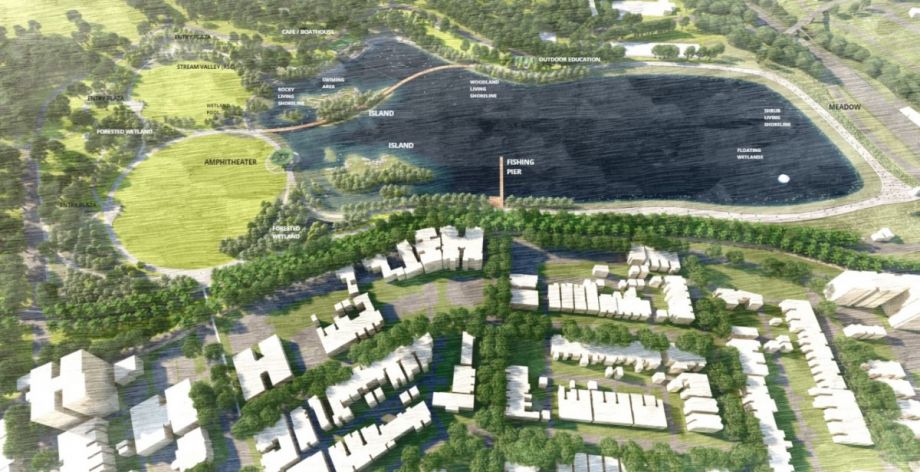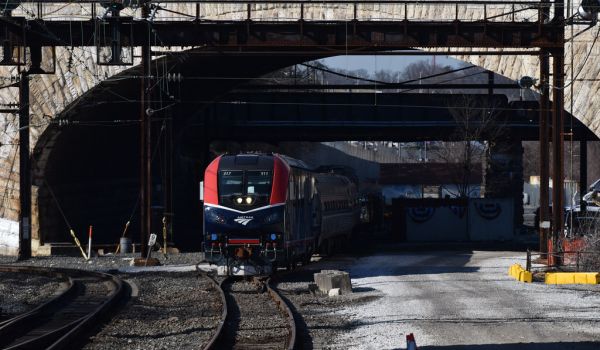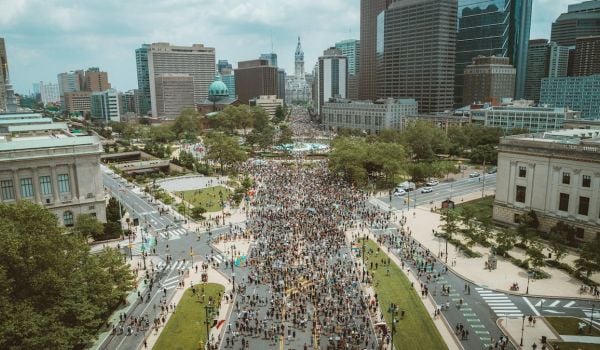Peering left from a triangular slope of Baltimore’s Druid Hill Park at its southerly Madison Avenue entrance, a visitor can grasp renowned landscape architect Howard Daniels’ idyllic vision: a grassy expanse, a varying canopy of dozens of trees, an array of paths filled with dog walkers, joggers and bikers, and green hills rolling west.
The rest of this view is less serene, however. Just ahead and to the right is a mess of construction that since 2017 has consumed Druid Lake, a man-made reservoir currently partially drained and covered by machinery, large pipes and assorted building materials as part of an ambitious $140 million drinking water storage project. Just behind, steps from the grass at the entrance, are three lanes of traffic noisily speeding west along Druid Park Lake Drive.
Baltimore’s best chance of fixing this conflicting scene is currently just an idea. Since the spring, architects, engineers and city parks officials have been engaging the public to help dream up the Druid Lake Vision Plan, convening hundreds of attendees at virtual and in-person gatherings to weigh in on preliminary future designs for the reservoir.
In interviews, principals from Unknown Studio, a local landscape architecture and urban design firm leading the vision plan team, likened the creative opportunity to that of the transformations of Echo Park Lake in Los Angeles nearly a decade ago or the sprawling “Heart of the Park” project at Memphis’ Shelby Farms. New proposed amenities for Druid Lake range from a boat launch situated next to a combined cafe-boathouse, an outdoor education building, an Olympic-sized swimming area, a fishing pier and a waterside amphitheater shell to entirely new islands, floating wetlands and a “living shoreline,” not to mention adjacent green and woodland spaces to build upon Daniels’ naturalist vision.
Noticeably absent in these renderings is the iron fence that has long walled off the lake from public use, and of course the construction that has covered Druid Lake’s western side for half a decade amid installation of two massive drinking water storage tanks. The popular, encircling 1.5-mile walking and biking loop has also been revived.
“I think that people are just so excited about an opportunity to have a lake that they can get back to,” says engineer Odessa Phillip, whose firm Assedo Consulting has been steering the vision team’s public outreach to neighbors and others across Baltimore and collating the feedback. In addition to support for swimming and nature-connected amenities, “the biggest thing we saw is they want to walk, they want to be able to get back to a place where they can walk, run, bike, access the park. They missed that piece a lot.”
That last wish, for access, has eluded neighbors since long before the recent construction. Once bounded by two-lane roads, the south and west side of the country’s third-oldest park today are surrounded by de facto speedways ranging from five to nine lanes, curtailing easy walking access from primarily Black neighborhoods just footsteps away. Amid a round of futuristic planning underway, city officials, neighbors and other stakeholders agree that Baltimore must simultaneously reckon with the racially divisive planning decisions of the past. Acknowledging that history and weighing how to reflect Baltimore’s Black culture — with educational and Black-led programming, for example — at Druid Lake has figured prominently into the public engagement phase so far, officials and stakeholders say.
“We need to restore the connection, the front-door relationship between the park” and neighborhoods that “were cut off through historically racial injustices,” says Adam Boarman, capital planning chief for Baltimore City Recreation and Parks. “We’ve been very outright and honest about that history, and we don’t want to sweep it under the rug. We want to tackle it head on.”
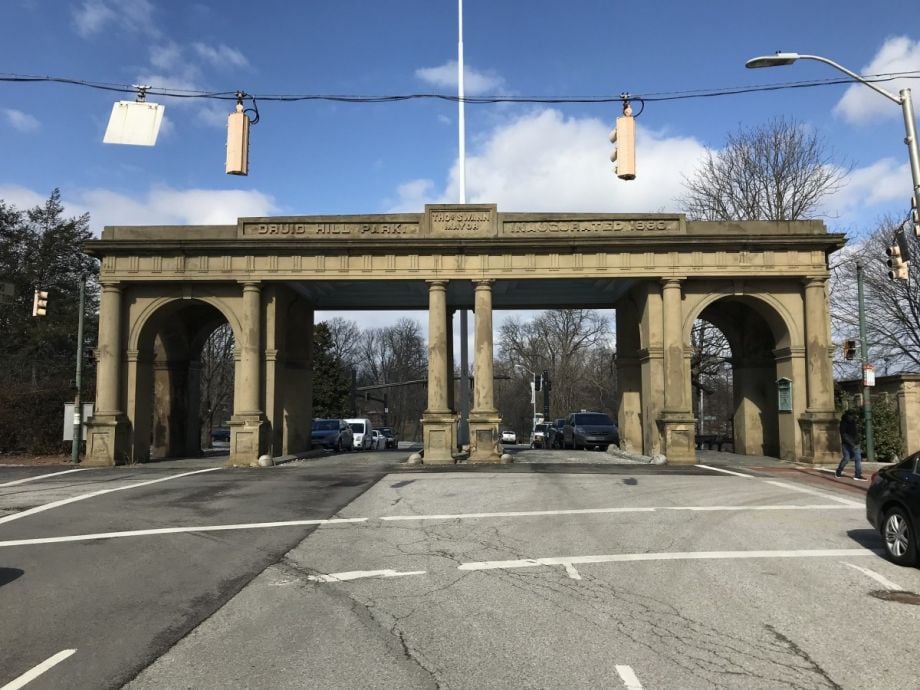
One of the car-centric entrances to Druid Hill Park (Photo by Baltimore Heritage / Public domain)
The waters of Druid Hill attracted humans for centuries before the park housed a manmade lake. Claire Agre and Nick Glase, principals with Unknown Studio, said their team has dug into the area’s anthropological lore to inform the future vision. They’ve learned how it was formerly inhabited by Susquehannock Indians, who in 1652 ceded the land to Maryland colonizer Lord Baltimore; about the park’s historic cemeteries and yet-undiscovered graves; even the location of Maryland’s first known baseball diamond, Flat Rock, now covered by Druid Lake.
They also surveyed the historic topography, including natural springs and former tributaries that criss-crossed the landscape before the city dammed the park’s western edge in 1863 to build the reservoir. “It is a fascinating tapestry of inhabitation,” Agre said. “People have been there for so long because of the water.”
Under private ownership for over two centuries, the land served as the estate of one of Baltimore’s seven originating commissioners, Dr. George Buchanan, and of his son-in-law, Nicholas Rogers, who owned a plantation there worked by enslaved people. It was his grandson, Nicholas Lloyd Rogers, who in 1860 sold the lion’s share of the park to the city, per historical records.
At its dedication, Mayor Thomas Swann proclaimed that Druid Hill would provide a refuge of “nature in its undisturbed simplicity and grandeur,” serving “the whole people,” regardless of origins, religion, profession or status.”
This proved to be true, if in segregated fashion. Until 1955, Druid Hill hosted separate tennis courts, swimming pools, playgrounds and other facilities for Black and white visitors. Its borders, however, remained accessible. Visitors could arrive from across the city on several streetcar lines, all now long gone, and neighbors could enter from one of two dozen entrances from neighborhood roads, according to a 1927 aerial map published by The Access Project (TAP) Druid Hill.
“Basically every single side street that abutted the park was an entrance to the park,” says Graham Coreil-Allen, a founder of TAP Druid Hill and a public artist and community leader in the nearby Auchentoroly Terrace neighborhood.
Just eight entrances — only five along the south and western edges, all at busy intersections — remain today. Much of the outer parkland from nearly a century ago now holds roads that shuttle cars to and from the city. In the mid-1940s, despite protests from the local NAACP chapter and neighbors, and in a move contrary to Daniels’ design and Swann’s pledge of undisturbed nature, officials proceeded with a plan to build the Druid Hill Expressway along the tree-lined, two-lane roadways of McCulloh Street and Auchentoroly Terrace. The plan, approved by the Baltimore City Council, turned them into one-way roads separated by a large median, and the city cut down 250 trees to build the highway on existing parkland.
A decade later, amid build-out of Baltimore’s now-arterial Jones Falls Expressway, Mayor Thomas D’Alesandro successfully pushed a plan to turn two-way Druid Park Lake Drive into a feeder road for the interstate. Finished in 1962, the one-two punch of highway construction helped accelerate flight of working-class families to the suburbs while leaving Black neighborhoods physically separated from the park that was once in their front yard.
Neighbors today are living out the effects of these decisions. Some residents in Auchentoroly Terrace have told the vision planning team of how seniors and people who use wheelchairs fear crossing to attend the weekly Druid Hill Farmer’s Market and jazz performances on Wednesdays. They instead set up lawn chairs across the street to listen in.
Monalisa Diallo lives in Mondawmin, several blocks from another prominent entrance at Gwynns Falls Parkway that houses the Rawlings Conservatory and the gateway to the Maryland Zoo. She sometimes opts to catch a ride with her sister rather than walk to the park; cars constantly fly by her home, and the pedestrian signals at the intersection are dangerously short.
When she does walk, she can make it across OK, she says — “sometimes I have to speed up a little bit” — but “for someone that is wheelchair-bound or has devices they use to walk, or who maybe just doesn’t walk as fast as I do, I fear for those people.”
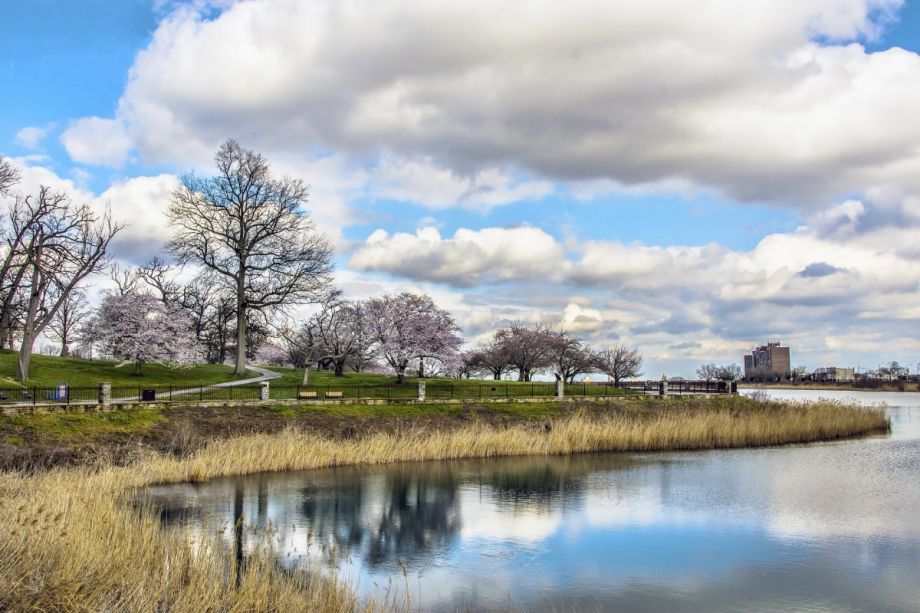
(Photo by Bruce.Emmerling / Public domain)
While it’s just outside their scope of work, landscape architects and park officials working to produce a draft vision plan by this fall argue a successful Druid Lake redesign must calm traffic and put pedestrians first. The city should aim to “return to a parkway concept” with fewer lanes for cars and more multimodal paths surrounding the lake, said Glase, of Unknown Studio. “It’s more about easy accessibility across it — it’s a tree-lined street, it feels like a coherent part of the overall park, it contributes to it.”
Another agency is already looking into it. Baltimore’s Department of Transportation is separately rethinking the traffic arrangement through the Druid Park Lake Drive Complete Streets Design Effort, initiated by now-former Councilman Leon Pinkett. Baltimore enacted its Complete Streets ordinance in December 2018, committing to less car-centric and more pedestrian-focused transportation planning, and this spring the city rolled out a local design manual.
Just before Rec and Parks’ team began sharing ideas for Druid Lake’s future in the spring, the transportation department and its hired team began collecting public feedback on the surrounding roadways. Ideas fielded so far include reducing the number of lanes, installing an elevated pedestrian walkway, adding new mid-block crosswalks and expanding sidewalks and adding more trees for shade.
While technically siloed as separate projects, officials say the timing worked out well and that the two plans can complement one another. City transportation planner Will Etheridge said coordination has been a “part of our overall strategy in how we complete the study.” Furthermore, he said DOT’s engineering, design and public outreach team, led by WSP, understands that outcomes of the Complete Streets study will inherently shape life inside the park.
“We really want to make sure that we bring some additional value to the park and so that people have better access to the park,” Etheridge said. “Hopefully we can make good on all of the opportunities that we have for this project.”
Fortunately for DOT, the agency isn’t starting off cold on dieting the roads around Druid Hill. For several years, Baltimore has undertaken a living experiment known as the Big Jump, stretching 1.4 miles from 28th Street in nearby Remington up Druid Park Lake Drive, that uses water-filled plastic barriers to cordon off a traffic lane for use by walkers, cyclists and wheelchair users. Supporters have called for making it a permanent fixture, saying it provides a safe place to exercise, run errands and traverse Baltimore City’s north-south dividing line of I-83.
While some drivers have complained the Big Jump creates a troublesome bottleneck, recently published traffic study results beg to differ. Data collected over four one-week periods in 2018 and 2019 found “no significant travel time impact” on neighboring streets or parallel routes and no adverse effects on car mobility, per the report. Analyzing city traffic crash data, the study also linked a reduction in crashes on Druid Park Lake Drive to the Big Jump’s presence.
DOT is now hoping to incorporate the Big Jump permanently into its Complete Streets plan. Matthew Hendrickson, a city bike planner with DOT who helps manage the project, said the Big Jump offers a precedent for successful traffic calming outside Druid Hill. “We showed we can make a difference that can generate momentum to make these larger-scale changes.”
Such alterations often spur initial confusion and angst among drivers, but they soon learn “the sky isn’t falling,” he said. The trade-off, he added, is “really just unlocking that corridor so that so many other people can get around.”
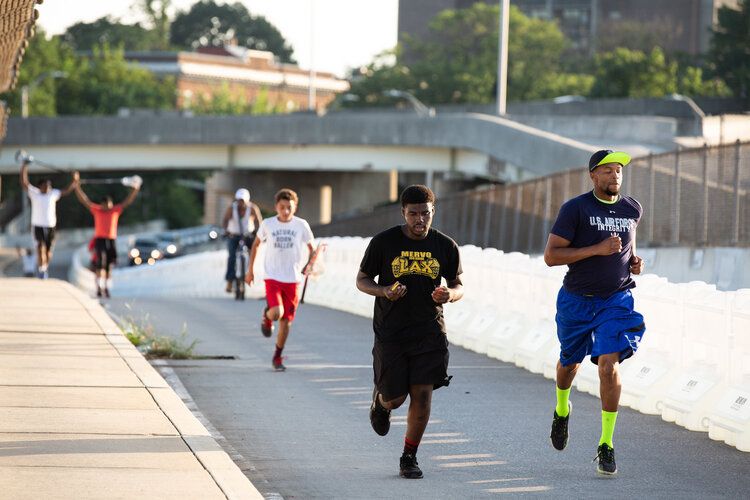
The Big Jump (Photo via Bikemore)
The Druid Hill vision planning team is set to make one more public presentation of its findings and designs in September, and will then present a final report to city officials by the end of October.
From there, it will be a waiting game. Boarman predicts the reservoir’s transformation could begin by 2026, but “it all comes down to funding.” The case will be similar for the Complete Streets redesign of Druid Park Lake Drive. Etheridge said once a final concept is approved, likely in 2022, it will take at least six years in the city’s capital planning timeline for actual work to begin.
Money is a key factor, Boarman noted. Rec and Parks has allocated some money already for a first phase, he said, but the agency must explore longer-term options like creating a conservancy or other fundraising arm. Such an overhaul will likely cost tens of millions of dollars, depending on the final scale.
Whatever vision moves forward, the city must commit to it, said Coreil-Allen. Neighbors have cause to be jaded: Baltimore has touted plans to transform the park before — including in a 1995 master plan that called for new trails and traffic calming along Druid Park Lake Drive, among many other changes — without ultimately following through.
“Baltimore has a grand tradition of developing spectacular master plans that they then roll up and leave on a shelf to collect dust,” he said. “We don’t want to see that happen.”
From her standpoint blocks away, Diallo will know both plans are successful if they can collectively slow down the cars and invite people in. That means everything from safer crossings that improve public safety to new programming catering to regional visitors and the makeup of the neighborhood itself — she envisions music festivals, events celebrating Baltimore’s Arabbers and constant educational outreach to nearby schools.
In short, she said, the city can begin to right its historic wrongs with how Druid Hill Park was built, from the amenities it holds to the design of the surrounding roads, by now “advocating for Black people.”

Ethan McLeod is a freelance reporter in Baltimore. He previously served as an editor for the Baltimore Business Journal and the daily news website Baltimore Fishbowl. He's also written for CityLab, Slate, DCist and elsewhere.

